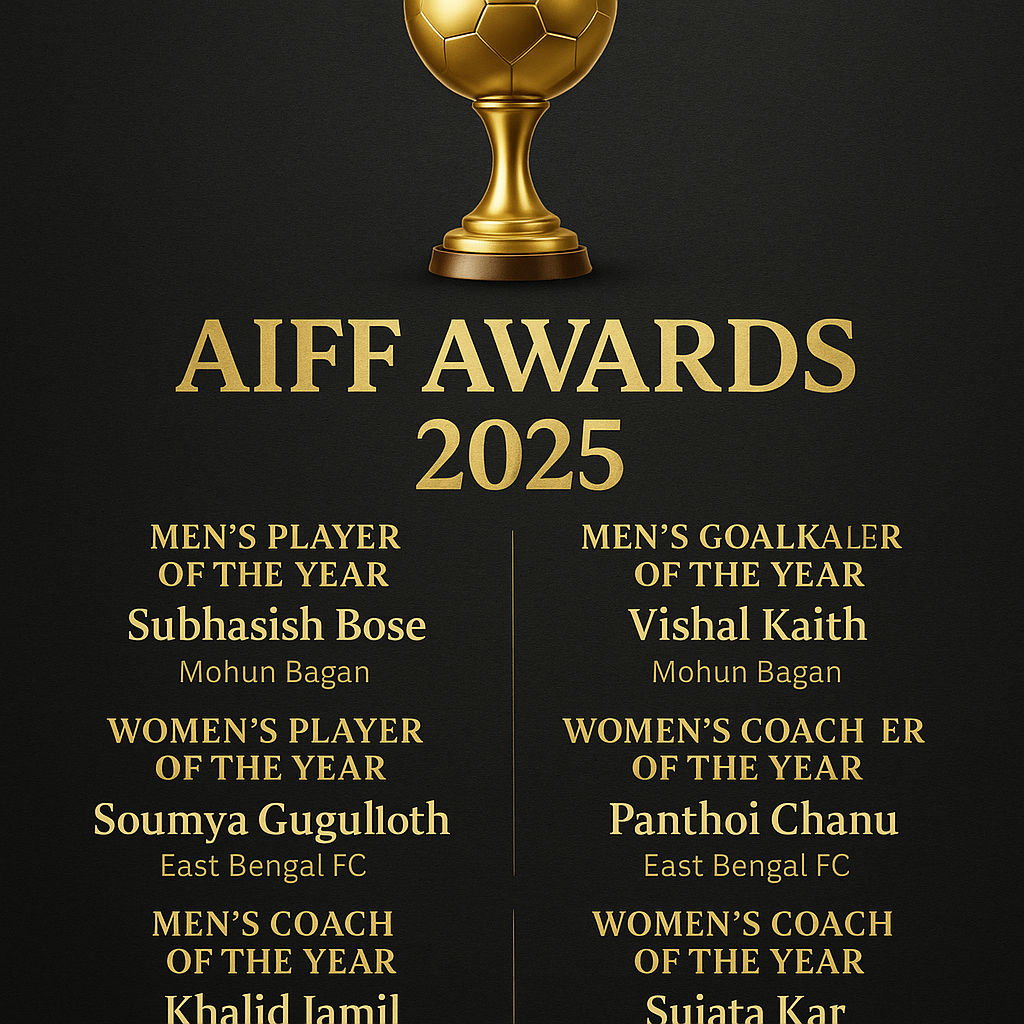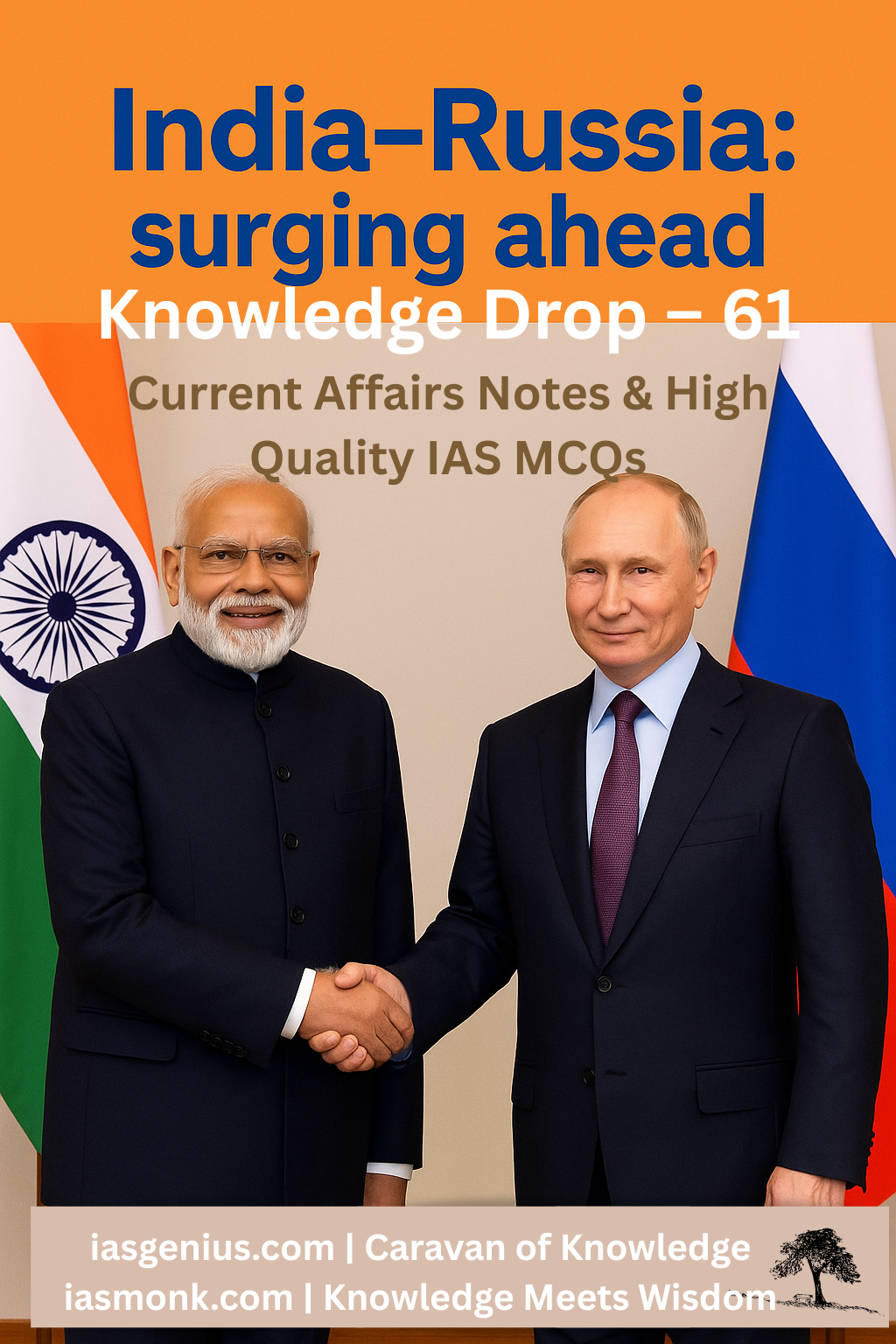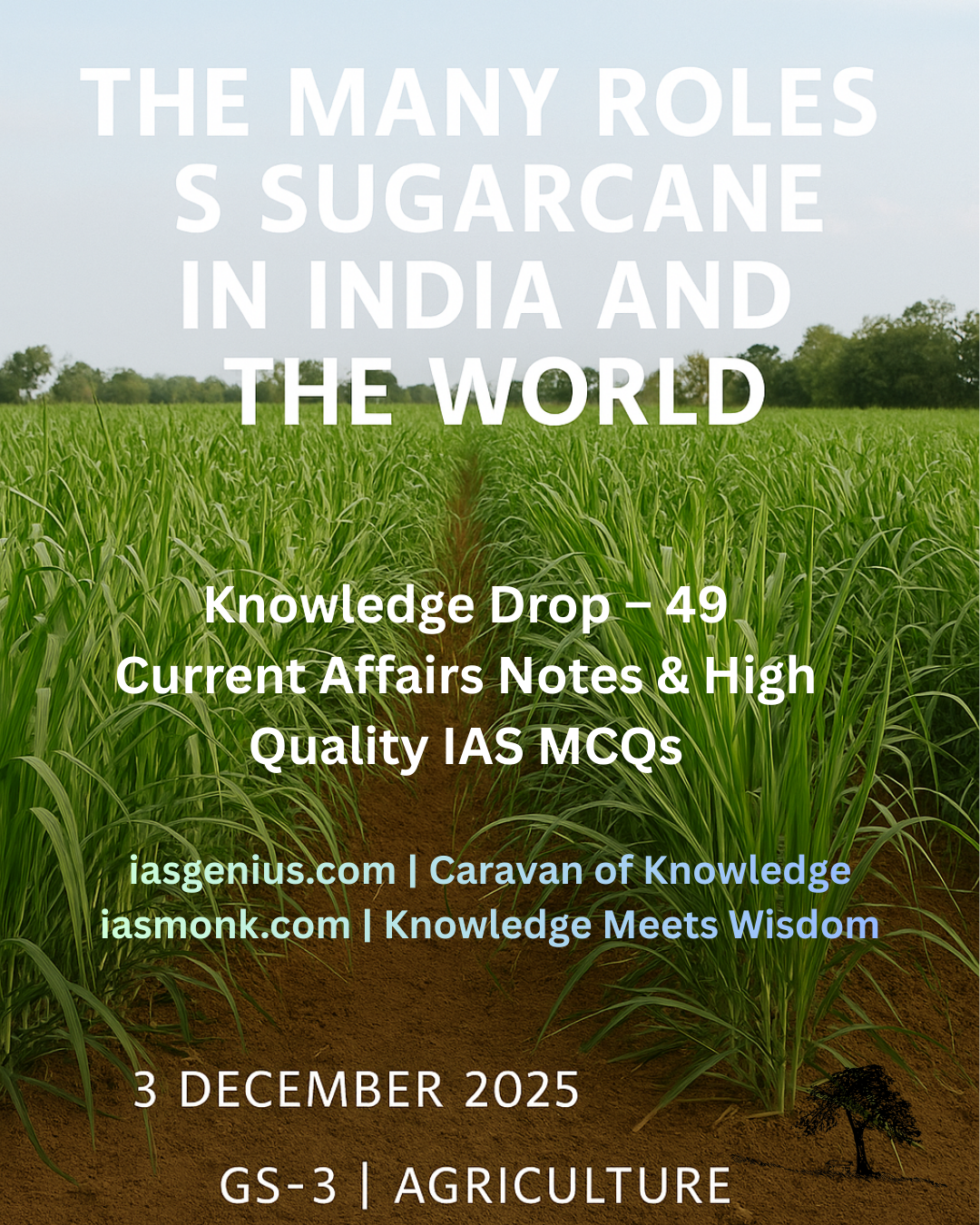
📅 May 2, 2025, Post 8: ⚽ AIFF Awards 2025: The Rising and the Resilient |Mains Essay Attached | Target IAS-26 MCQs Attached: A complete Package, Dear Aspirants!
🏆 The Rising and the Resilient

AWARDS — PETAL 029
📅 May 2, 2025
Thematic Focus: Sports Recognition, Institutional Growth, GS II – Governance in Sports
🌿 Opening Whisper
The game is not only won on the field — it is remembered in the applause that follows, in the names that rise.
🔍 Key Highlights
• The AIFF Awards 2025 were held on May 2, 2025, in Bhubaneswar, Odisha, recognizing top footballers and coaches from ISL and IWL.
• Awards celebrated not just victory, but consistency, grit, and brilliance in the 2024–25 season.
• Soumya Guguloth and Subhasish Bose were crowned the Women’s and Men’s Player of the Year, respectively.
• The event affirmed the growing institutional recognition of Indian football talent—across both genders and divisions.
🏅 Award Winners – AIFF 2025
⭐ Top Players of the Year
- Men’s Player of the Year: Subhasish Bose
→ Defender, Mohun Bagan | 7 goal contributions | 12 clean sheets - Women’s Player of the Year: Soumya Guguloth
→ Forward, East Bengal FC | 9 goals in 9 IWL matches
🧤 Goalkeeper of the Year
- Men’s: Vishal Kaith (Mohun Bagan)
→ 17 clean sheets in 31 matches - Women’s: Panthoi Chanu (East Bengal FC)
→ 7 clean sheets in 14 IWL games
🧠 Coach of the Year
- Men’s: Khalid Jamil (Jamshedpur FC)
- Women’s: Sujata Kar (Sreebhumi FC)
🌱 Promising Talent
- Promising Men’s Player: Brison Fernandes (FC Goa)
- Promising Women’s Player: Thoibisana Chanu (Sreebhumi FC)
⚽ Institutional Value of the AIFF Awards
- Recognizes excellence and discipline across the Indian football ecosystem.
- Encourages state and club-level investment in both men’s and women’s football.
- Offers visibility and morale boost to young players, especially from less represented regions like Telangana and Manipur.
- Helps shape a culture of reward and remembrance, vital for nurturing talent in emerging sports.
📘 GS Paper Mapping
Prelims:
• AIFF Awards 2025 – Categories and Recipients
• ISL and IWL Key Players and Coaches
Mains:
• GS II – Sports governance and institutional recognition
• GS II – Role of federations like AIFF in talent development
• GS II – Gender parity and promotion in sports
🔮 A Thought Spark — by IAS Monk
An award is not just a trophy. It’s a bookmark in a long, unwritten epic. And Indian football is only on its first page.
High Quality Mains Essay For Practice :
Word Limit 1000-1200
⚽ India’s Men in the World of Football: Rising Against the Odds
For decades, India has been called the “sleeping giant” of world football—a phrase that embodies potential as much as it does disappointment. In a nation of over a billion, where cricket is almost religion, football has long remained in the shadows. Yet, recent developments—both on and off the pitch—suggest that India’s men in football are no longer content with sleep. They are beginning to rise, push, and demand their space in the global sporting arena.
From Subhasish Bose’s leadership in defence to Vishal Kaith’s commanding presence as a goalkeeper, India is quietly building a new generation of footballers—skilled, professional, and determined to carry the tricolour onto the global pitch.
🧭 A Historical Backdrop: Once Called the “Brazil of Asia”
Football is not new to India. In fact, some of the oldest football clubs in Asia—Mohun Bagan (est. 1889), East Bengal (1920), and Mohammedan SC—are Indian. Mohun Bagan’s iconic victory against East Yorkshire Regiment in 1911 was not just a sporting triumph; it was a nationalist moment. Indian football had spirit and passion.
Yet, after a promising post-independence phase—where India qualified for the 1950 FIFA World Cup (but did not participate)—the decline began. Lack of infrastructure, professional training, long-term vision, and political support pushed the sport to the margins.
🌱 The Reawakening: Rise of ISL and Professionalism
The Indian Super League (ISL), launched in 2014, has been the single most impactful reform in Indian football. Modeled on global franchise leagues, it brought foreign coaches, international exposure, better wages, and media attention to Indian players.
For the first time, young boys from small towns could dream of being scouted, trained, and paid to play. Players like Sunil Chhetri, Gurpreet Singh Sandhu, Anirudh Thapa, and now Subhasish Bose and Vishal Kaith have emerged from this ecosystem—not just as players but as symbols of India’s footballing promise.
The recently concluded season, where defenders and goalkeepers played pivotal roles, highlights how Indian football is evolving beyond just flair—it is becoming strategic, consistent, and team-centric.
🛡️ Subhasish Bose: A Defender with Grit
Subhasish Bose’s journey reflects the transformation of Indian football. A tireless fullback known for both defensive solidity and attacking overlaps, he has been a pillar for Mohun Bagan and the Indian national team.
His record in the 2024–25 season—seven goal contributions and 12 clean sheets—is a testament to modern football’s demands from defenders. In an era where fullbacks are expected to be both warriors and creators, Bose has stood out.
Importantly, he represents the new Indian footballer—fit, tactically aware, disciplined, and professional.
🧤 Vishal Kaith: The Last Line of Defence
Vishal Kaith’s 17 clean sheets in 31 matches are not just numbers; they represent composure under pressure. A former player for FC Pune City and Chennaiyin FC, Kaith’s rise through the ISL ranks culminated in a national team call-up—an achievement that reflects the growing competitiveness of Indian domestic leagues.
What sets Kaith apart is his agility, communication, and shot-stopping—traits that are nurtured only in structured, high-pressure match environments. That he now leads one of the most successful ISL sides shows that Indian goalkeepers are no longer liabilities; they are game-changers.
🌍 Global Ambitions, Local Roots
Indian players are now participating in training camps abroad, going for overseas trials, and even playing in smaller European leagues. Though no Indian male footballer has yet made it to a top-tier European league in a regular playing role, the ambition is real.
The AIFF has also signed strategic partnerships with federations like Germany, Portugal, and Croatia, aiming to offer Indian talent both exposure and competition.
But for global dreams to materialize, India must address three critical gaps:
- Grassroots Development
→ Early age coaching, structured leagues, and nutrition programs - Scouting and State-Level Support
→ Tapping into raw talent from underrepresented states like Jharkhand, Bihar, and the Northeast - Sports Science and Recovery
→ Injury prevention, fitness tracking, and career longevity
🧠 Tactical Evolution and Coaching Culture
Gone are the days when Indian football teams played “kick and run.” Today’s ISL coaches—many of them UEFA license holders—have introduced tactical diversity: high press, zonal marking, overlapping fullbacks, and structured build-up.
This shift has allowed Indian players to learn in real match situations, not just through drills. Players like Subhasish and Vishal Kaith are products of this tactical environment—they understand formations, adapt to game flow, and make split-second decisions.
🇮🇳 Football as National Identity
For states like West Bengal, Kerala, Manipur, and Mizoram, football has always been more than sport—it’s identity, pride, and community. Now, with players from these regions rising nationally, there is cultural momentum behind the sport.
Football also holds the power to unify India across language and class divides. Whether it’s a boy from Kashmir or a girl from Manipur, the football field is a leveler.
🧭 The Road Ahead: Turning Momentum into Milestone
India’s next frontier is qualification for the AFC Asian Cup knockout stages, and eventually the FIFA World Cup qualifiers. For that, the AIFF must:
- Increase league duration (current season too short for player rhythm)
- Invest in sports infrastructure, especially in Tier-2 and Tier-3 cities
- Ensure long-term contracts and mental health support for players
- Create a global scouting and training network through embassies and diaspora
🕊️ Conclusion: From Possibility to Performance
Indian football is no longer asking for attention—it is demanding recognition. The men who play it—from Subhasish in defence to Kaith in goal—are laying foundations for something far greater than themselves.
In a few years, perhaps, we will see Indian clubs making a mark in Asia, and Indian players being picked for international clubs on merit, not novelty.
Until then, every clean sheet, every tackle, every pass forward is a quiet promise: India has arrived. And we are not turning back.
“The world’s greatest football stories were not written in Europe. They were born in hunger, in hope, and on fields like ours.”
— Anonymous Indian Coach
Target IAS-26: Daily MCQs :
📌 Prelims Practice MCQs
Topic: Indian Football, AIFF Awards, Sports Personalities
MCQ 1 — Type 1: How many statements are correct?
Q. Consider the following statements regarding the AIFF Awards 2025:
1. Vishal Kaith was awarded Men’s Goalkeeper of the Year for keeping 17 clean sheets in 31 matches across competitions.
2. Subhasish Bose, the AIFF Men’s Player of the Year, is a midfielder known for his high goal-scoring record.
3. The AIFF Women’s Coach of the Year was awarded to Sujata Kar of Sreebhumi FC.
4. The AIFF Awards ceremony was held in Pune, Maharashtra on May 2, 2025.
How many of the above statements are correct?
A) Only one
B) Only two
C) Only three
D) All four
🌀 Didn’t get it? Click here (▸) for the Correct Answer & Explanation
✅ Correct Answer: B) Only two
🧠 Explanation:
• Statement 1 – Correct (Vishal Kaith did have 17 clean sheets in 31 appearances).
• Statement 2 – Incorrect (Subhasish Bose is a defender, not a midfielder).
• Statement 3 – Correct (Sujata Kar of Sreebhumi FC won Women’s Coach of the Year).
• Statement 4 – Incorrect (The awards were held in Bhubaneswar, Odisha).
MCQ 2 — Type 3: Which of the above statements is/are correct?
Q. With reference to Indian football institutions and leagues, consider the following statements:
1. The Indian Super League (ISL) was launched in 2014 to promote professional men’s football in India.
2. AIFF Awards are given to both men and women players, coaches, and emerging talents annually.
3. East Bengal FC and Mohun Bagan are among the oldest football clubs in Asia.
Which of the above statements is/are correct?
A) 1 and 2 only
B) 2 and 3 only
C) 1 and 3 only
D) All three
🌀 Didn’t get it? Click here (▸) for the Correct Answer & Explanation
✅ Correct Answer: D) All three
🧠 Explanation:
• All three statements are factually accurate. ISL began in 2014, AIFF awards recognize both men and women, and clubs like East Bengal (1920) and Mohun Bagan (1889) are among Asia’s oldest.
MCQ 3 — Type 3: Which of the above are correct?
Q. With reference to Multilateral Development Banks (MDBs), consider the following statements:
1.They are being urged to stretch their balance sheets to increase lending capacity.
2.They must increasingly mobilize private finance at affordable rates.
3. MDBs currently operate under the governance of the World Trade Organization.
Which of the above statements is/are correct?
A) 1 and 2 only
B) 2 and 3 only
C) 1 and 3 only
D) All three
🌀 Didn’t get it? Click here (▸) for the Correct Answer & Explanation
✅ Correct Answer: A) 1 and 2 only
🧠 Explanation:
Statements 1 and 2 correctly reflect the UN proposals for MDB reform.
Statement 3 is incorrect – MDBs are independent institutions; they do not operate under WTO governance.


















